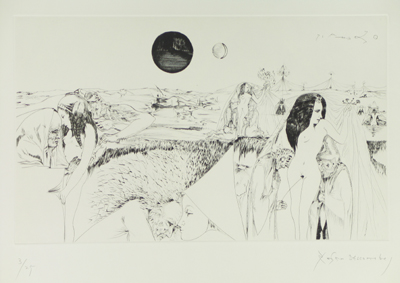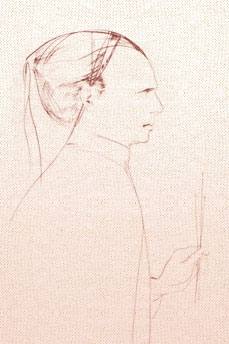EXHIBITION ROGER DESCOMBES
Article on the exhibition which took place at the gallery “La Gravure” that was owned by Madame Pierre Cailler (the well known Swiss book publishers). It affords a useful analysis of the artist’s method of working when engraving.
Roger Descombes is the guest artist at the gallery “La Gravure” in Pully (Lausanne) until the 10th July.  This is incontestably a very great exhibition because the fifty dry point engravings on show there are synonymous with absolute purity.
This is incontestably a very great exhibition because the fifty dry point engravings on show there are synonymous with absolute purity.
Purity of form first of all, because Descombes, who from the start of his engraving does not know what he will delineate, is guided by his subconscious. One form leads to another. A line made will promote a second one. There is in Descombes’ engraving an alliance of marks and lines made by him which gives his drawing a homogenous whole. His engraving can be ‘read’ without any interruption just like the free-flowing rhythm made by the outline of an egg when it is viewed because it is a perfect form.
Purity in the message also, in that once Descombes has incised the first lines almost haphazardly, in total freedom, he sees appearing from these first lines an idea, a signification, a theme. From then on, it’s only a question of letting his hand run over the surface of the copper plate. The drawing is in him; he can ‘see’ it in its entirety as though already engraved on the plate. All that he needs to do is to ‘trace’ over with the steel point of his burin the lines. It is from this that the surrealist quality of Descombes’ works comes about; promoting a certain kind of freedom. I would go further and call it a total freedom of expression linked to an accumulation of thoughts arrived at by him second by second.
A “Surrealist”, we said, a “Symbolist”, we have also implied, and with regards to Descombes, we need to add to these labels the term “meditative”. This meditative quality is even possibly the one most important feature of this work which carries with it all the weight of human destiny. A destiny evoked by the artist with blazing integrity and with a spiritual force which seems to have gathered its strength from oriental wisdom.
Translation by Louise Descombes, October 2010.
B.-P.Cruchet
 Français
Français English
English